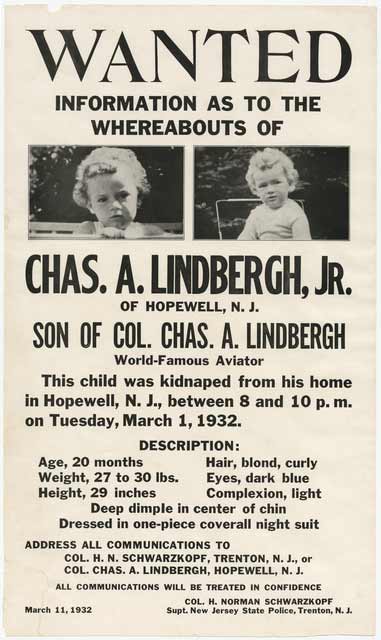 |
| Wanted Poster |
Charles Lindbergh is an
American aviation legend. At the height of his career, he was a record-breaking
hero. History remembers him as such, but he was more than that. Charles Lindbergh
was the father of a boy who was not even two years old when he was stolen from
his family and murdered. Charles and his wife Anne endured months of ransom
notes and searching for their child only to find that he had probably been dead
before they realized he was missing. The horrible crime created a media frenzy
that drove the Lindberghs from the United States.
On the night of March 1,
1932, the Lindbergh family was relaxing in their Hopewell, New Jersey home.
Charles Lindbergh Jr. was tucked away in his crib. The rest of the household
was going about business as usual. At around 10 o'clock, the Lindberghs' nanny
went to check on her charge. He was not in his room. She informed the baby's
parents immediately. A search was conducted and the police were informed. The
child was not in the house. It is though that the kidnapper(s) stole him from
his room around 9 p.m. A note asking for $50,000 in ransom money was on the windowsill
of the room.
When police arrived to
conduct their investigation, they found several clues, but none of them would
prove helpful until years later. There was mud on the floor of Charles
Lindbergh Jr.'s room, presumably dragged in on the kidnapper's shoes. Also
found were the remains of a broken ladder, which the kidnapper probably used to
reach the boy's window. Police found footprints below the window, but none were
clear enough for forensic use. There was no indication that the kidnapper hurt
Charles Lindbergh Jr. inside of the home.
Police spoke with household
workers and people close to the Lindbergh family. There were no leads. All they
had to go on was the ransom note and twelve others that followed. Charles
Lindbergh got the second ransom letter on March 6. It stated that the amount
required was now $70,000. A third note arrived two days later, stating the
correspondence would now go through the newspaper. Negotiations for payment of
ransom began the next day. Several more ransom notes followed, all handled
through an agreed upon intermediary. The kidnapper(s) produced the child's
sleepwear as proof that they had Charles Jr. After a series of more
exasperating communications, the amount was increased to $100,000.
Eventually, $50,000 was
turned over to a man with the alias John in exchange for information on Charles
Lindbergh Jr.'s whereabouts. The information was false. The area was searched
several times. The child was not there. John lied and ran with the money. More
than one month later, a motorist found Charles Lindbergh Jr.'s body on the side
of the road less than five miles from the Lindbergh residence. The baby
suffered massive head injuries. His tiny body was marked with animal bite
wounds and it was decaying rapidly. An autopsy showed that the kidnapper killed
Charles Jr. right after he stole him. It is possible that the kidnapper
accidentally dropped the baby when exiting the house.
The investigation continued,
this time in an effort to catch the person or persons who had stolen Charles
and Anne Lindbergh's son, murdered him and then extorted money from his
grieving parents. There were numerous false leads and claims. Police sifted
through these whilst trying to find the money used to pay the killer or
killers. It was years before investigators finally got a worthwhile lead.
On August 20, 1934, some of
the gold certificates used as ransom turned up in New York. These certificates
eventually led back to Bruno Hauptmann, who fit the description of John. The
police searched his house and found $13,000 of the ransom money, the same type
of wood used to make the ladder, the intermediary's contact information and
goods paid for with ransom money. Later, his handwriting was compared with that
on the ransom notes–it matched. Bruno's case did not look good, but he denied
everything.
Hauptmann was brought to
trial on January 3, 1935. Charles Lindbergh was there every day of the
five-week trial. A the trial, the Lindberghs could no longer bear to live in
the United States where the press hounded them and their loss haunted them. It
did not matter that Hauptmann was found guilty and executed; they would never
find peace.
Conspiracy theorists posited
the possibility that Hauptmann was framed. Crime buffs stated (correctly) that
Hauptmann was convicted on circumstantial evidence that left a shadow of a
doubt. The fact is that the evidence against Bruno was convincing even if it
was circumstantial. If he was framed, it was an elaborate frame-up. Either way,
Charles Lindbergh Jr. was denied a long life because someone sought the wealth
of his parents.
Sources
FBI, The Lindbergh
Kidnapping, retrieved 12/2/10,
fbi.gov/about-us/history/famous-cases/the-lindbergh-kidnapping
Comments
Post a Comment